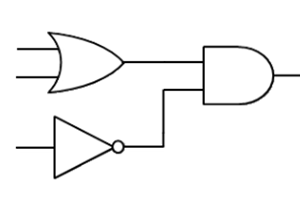How do computers make decisions?
Published:
 How computers make decisions with logic gates, which is the fundamental building block for how computers operate? Computers make decisions using logic gates, which are the fundamental building blocks of all digital circuits. A logic gate is a basic electronic component that takes one or more binary inputs and produces a binary output based on a logical operation. The basic logic gates are AND, OR and NOT gates. These gates can be combined to create more complex circuits that can perform more advanced logical operations.
How computers make decisions with logic gates, which is the fundamental building block for how computers operate? Computers make decisions using logic gates, which are the fundamental building blocks of all digital circuits. A logic gate is a basic electronic component that takes one or more binary inputs and produces a binary output based on a logical operation. The basic logic gates are AND, OR and NOT gates. These gates can be combined to create more complex circuits that can perform more advanced logical operations.
What are Logic Gates?
Logic gates are fundamental building blocks in the design of digital circuits. They perform logical operations on input signals, which can be either a high voltage level (represented by a logical “1”) or a low voltage level (represented by a logical “0”). The output of a logic gate is also a binary signal, which can be either a logical “1” or a logical “0”.
There are several types of logic gates, including AND, OR, NOT, NAND, and NOR gates. Each gate performs a specific logical operation on the input signals, as determined by its truth table. For example, an AND gate produces a logical “1” output only when both of its inputs are logical “1”. In contrast, an OR gate produces a logical “1” output when at least one of its inputs is a logical “1”.
The NOT gate, also known as an inverter, produces an output that is the logical opposite of its input. That is, if the input is a logical “1”, the output is a logical “0”, and vice versa. The NAND and NOR gates are combinations of AND and NOT, and OR and NOT gates, respectively.
Logic gates are typically implemented using transistors, which are semiconductor devices that can amplify or switch electronic signals. In modern digital circuits, logic gates are often integrated into a single chip, known as an integrated circuit (IC). This allows for high-density and low-power consumption designs, which are crucial in many applications, including mobile devices, automotive systems, and medical devices.
The importance of logic gates in computer science cannot be overstated. They are used in a wide range of applications, including arithmetic operations, memory circuits, and control systems. For example, a basic adder circuit can be constructed using several logic gates to perform binary addition. Similarly, a memory cell can be designed using logic gates to store and retrieve binary data.
Types of Logic Gates:
NOT Gate: A NOT gate, also known as an inverter, has only one input and one output. It produces an output that is the opposite of its input. That is, if the input is a logical “1”, the output is a logical “0”, and vice versa. The symbol for a NOT gate is a small circle at the input, followed by an arrow pointing towards the output.
AND Gate: An AND gate has two inputs and one output. It produces a logical “1” output only when both inputs are logical “1”. In other words, it requires both inputs to be true for the output to be true. The symbol for an AND gate is a large dot at the intersection of two input lines, followed by a line for the output.
OR Gate: An OR gate also has two inputs and one output. It produces a logical “1” output if at least one of its inputs is a logical “1”. In other words, it requires at least one input to be true for the output to be true. The symbol for an OR gate is a large plus sign at the intersection of two input lines, followed by a line for the output.
XOR Gate: An XOR gate, or exclusive OR gate, has two inputs and one output. It produces a logical “1” output if either one input or the other is a logical “1”, but not both. In other words, it requires one input to be true and the other to be false for the output to be true. The symbol for an XOR gate is a large plus sign with a small circle at the intersection of two input lines, followed by a line for the output.
The different types of logic gates can be combined to create more complex circuits, such as full adders, flip-flops, and multiplexers. These circuits are used in a variety of applications, including arithmetic operations, memory circuits, and control systems.
How Do Logic Gates Work?
At the heart of logic gates are transistors, which are tiny electronic switches that can turn on or off based on the electrical charge they receive. Transistors are the building blocks of all electronic devices and are the backbone of modern computing.
The arrangement of transistors, connected to inputs and outputs, can create a circuit that performs logical operations. When an electrical current is applied to the input of the circuit, the transistors either allow the current to flow or block it based on their on or off state, resulting in the output. In other words, the output is the result of a logical operation performed on the input based on the configuration of the transistors.
Each type of logic gate has a unique truth table that defines the relationship between its inputs and outputs. For example, an AND gate only produces a logical “1” output if both of its inputs are logical “1”. The truth table for an OR gate, on the other hand, shows that the output is “1” if either input is “1”.
The combination of different types of logic gates can create complex circuits that perform more complex operations. These circuits are used in a variety of applications, including arithmetic operations, memory circuits, and control systems.
Why Are Logic Gates Essential for Computing?
Logic gates enable computers to perform complex operations using only ones and zeros. These operations are based on Boolean logic, which is a type of algebra that uses only two values, “true” or “false,” represented by ones and zeros. By combining different types of logic gates, computers can perform a wide range of logical operations, such as AND, OR, NOT, and XOR, and process large amounts of data quickly and efficiently.
In addition to processing and storing data, logic gates also allow computers to communicate with other devices. They are used in the design of communication circuits, such as modems and network adapters, which enable computers to transmit and receive data over networks. Logic gates are also used in the design of memory circuits, such as RAM and ROM, which enable computers to store and retrieve data quickly.
Furthermore, logic gates are essential for performing calculations. They are used in the design of arithmetic circuits, such as adders and multipliers, which enable computers to perform mathematical operations quickly and accurately. These circuits are essential for a wide range of applications, including scientific research, engineering, and finance.

 The year 2023 was full of various experiences for me. I took on the role of an Assistant Professor, and the journey had unexpected events like a major surgery, health issues within my family, starting a website, and picking up new hobbies. This post gives an honest overview of the good and bad moments that shaped my year. The foundation of everything in life is undoubtedly health. Without it, even the biggest achievements and detailed plans can fall apart. Health quietly influences our daily activities, professional goals, and personal relationships.
The year 2023 was full of various experiences for me. I took on the role of an Assistant Professor, and the journey had unexpected events like a major surgery, health issues within my family, starting a website, and picking up new hobbies. This post gives an honest overview of the good and bad moments that shaped my year. The foundation of everything in life is undoubtedly health. Without it, even the biggest achievements and detailed plans can fall apart. Health quietly influences our daily activities, professional goals, and personal relationships.  Ever wondered who the superheroes of the Java world are? Java Champions are like the rock stars of Java programming. They’re not just good; they’re exceptional! These are people who have shown their love for Java in outstanding ways. Java Champions are recognized as elite members of the Java community who have made significant contributions in various ways. Unlike certifications or titles that are earned through formal channels, becoming a Java Champion is an acknowledgment of a person’s ongoing and sustained efforts in the Java ecosystem.
Ever wondered who the superheroes of the Java world are? Java Champions are like the rock stars of Java programming. They’re not just good; they’re exceptional! These are people who have shown their love for Java in outstanding ways. Java Champions are recognized as elite members of the Java community who have made significant contributions in various ways. Unlike certifications or titles that are earned through formal channels, becoming a Java Champion is an acknowledgment of a person’s ongoing and sustained efforts in the Java ecosystem.  On November 24th, we observe Teachers’ Day in Turkey, a day that holds great importance and emphasizes the crucial role of education in our society. Mustafa Kemal Atatürk, a military leader and statesman, understood how education could profoundly shape a nation’s destiny. He believed that the progress and prosperity of a society were closely tied to the quality of its education system. Atatürk firmly believed that a well-educated and enlightened citizenry was the cornerstone for building a modern, democratic, and forward-thinking nation.
On November 24th, we observe Teachers’ Day in Turkey, a day that holds great importance and emphasizes the crucial role of education in our society. Mustafa Kemal Atatürk, a military leader and statesman, understood how education could profoundly shape a nation’s destiny. He believed that the progress and prosperity of a society were closely tied to the quality of its education system. Atatürk firmly believed that a well-educated and enlightened citizenry was the cornerstone for building a modern, democratic, and forward-thinking nation.